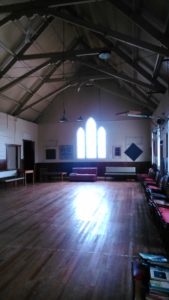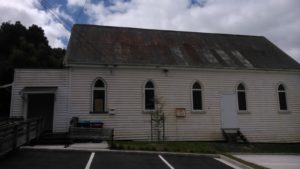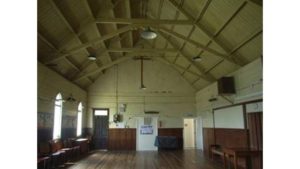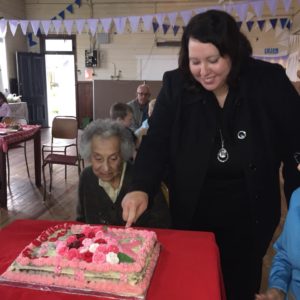In 1903 Saint Jude's Church commenced fund raising for the erection of its Sunday School Hall, the first such building to be constructed in the settlement. Thomas Moor's tender of £295 was accepted for erection of the Sunday School Hall in 1907, and a simple hall was added at the rear of the site. The foundation stone laying ceremony was attended by the Bishop of Auckland, Richard Neligan (1863-1922). The hall was dedicated in September 1907, and was used as a venue for local clubs and societies as well as for religious education.
The new structure was a comparatively plain timber building of ecclesiastical style with a rectangular footprint and a gabled roof. It was designed by the Auckland-based architect, Arthur Herbert White [d.1920]. White had earlier designed a Methodist church in Mt Eden Road (1898) and a hall for the Mt Albert Methodist Church (1901). His later works included a Sunday School hall for the Mt Eden Methodist congregation (1910); the Portland Buildings, Kingsland (1914); the Dominion Road Methodist Church [1926]; and the Caughey family home in Mt Albert.
The Sunday School Movement was pioneered in eighteenth-century Britain, where it provided basic literacy education alongside religious instruction. In New Zealand, Sunday Schools were among the first institutions established in the colony and were seen as promoting observance of the Sabbath and the opportunity for instruction concerning Christian doctrine. For generations many New Zealand children attended, although their parents may not have been practising members of a church congregation.
As well as supplying a venue for Sunday School teaching, the hall also provided for activities including a Mutual Improvement and Athletic Club, the Girl's Friendly Society, and a branch of the Church of England Men's Society. Shortly after the hall's opening, the Reverend T.J. Parry (1908-12) became the incumbent of Saint Jude's Church. Parry was later a chaplain in the First World War (1914-18), and also curate to Bishop Neligan after the latter had retired.
In March 1913 three classrooms were added to the south side of the hall at a time when it provided additional accommodation for nearby Avondale primary school. The contractor was a Mr Spargo. For four months from mid October 1914 volunteers of the first Maori contingent (580 all ranks) trained at Avondale camp prior to service at Gallipoli in the Maori (Pioneer) battalion. Some of its members are said to have attended and supported Saint Jude's Church over the summer. A number of local servicemen killed in the First World War were honoured in a memorial tablet and font installed in the church porch in 1921.
In 1919, the year Saint Jude's became a separate charge, a supper room was added to the hall. A vicarage was erected in 1924. In 1925 electricity replaced the gas lighting installed in the church in 1908, and water was laid on to the hall. Church services were reduced for some months during the Great Depression of the nineteen thirties and the vicarage was let. About this time Blake Street was renamed Saint Jude Street. Lead-light windows were installed in the sanctuary in 1937 to commemorate early Avondale residents James and Elizabeth Mowbray Binstead.
During the Second World War (1939-45) the hall was made available free of charge for the farewells of soldiers on final leave and was also used by a study group of the Avondale Home Guard. A Celtic cross memorial monument designed by McNab and Mason was erected in 1947 to commemorate twelve servicemen killed during the recent war. Saint Jude's Scout Group was formed in 1949 and met in the hall for several years. From the early 1950s, a period of increasing suburbanisation and population growth, the hall was also the venue for Brownies, Girl Guides, Mothers' Union and Young Wives' Fellowship. Saint Jude's ministry also extended to Waterview where Saint Christopher's Church was erected in 1954. Toilet facilities in the hall were modernised in 1996 and the church was reroofed in 2003. The centenary of the hall was celebrated in 2007.
The hall is now in need of significant refurbishment, and a programme of work is planned for the near future. This has begun with a series of reports on the heritage value and condition of the hall. These have been funded partly by the Whau Local Board (Whau Local Grants) and the Regional Historic Heritage Grants Programme.
The hall remains available for hire on a regular or casual basis.




